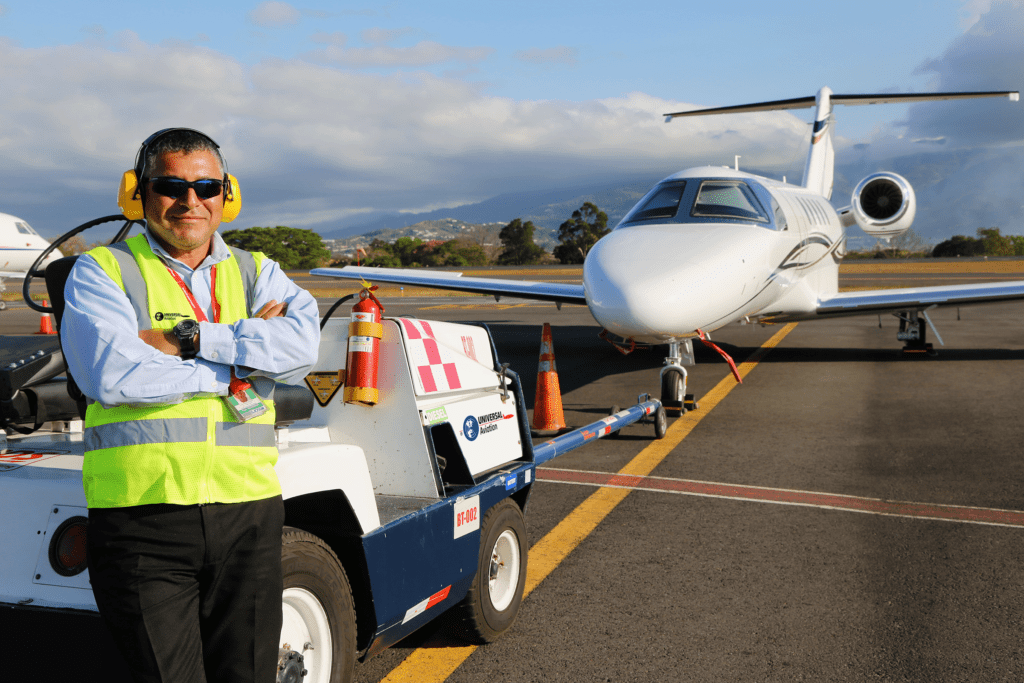Costa Rica: 2025 Business Aviation Destination Guide

For more detailed information on specific destinations within Costa Rica, please visit our articles on:
Costa Rica is a friendly destination for business aircraft operations. Ground handling quality is high at major airports, and most services are readily available. Still, there are many issues to be mindful of, including the availability of services at your destination, customs and immigration services, and parking issues – to name a few. It’s also important to be mindful of documentation needs at your destination.
Airport Options
AOEs
Costa Rica has four airports of entry (AOEs). San Jose (MROC) and Liberia (MRLB) are the primary destinations for both business and tourism in Costa Rica. These are also excellent tech stops with quick turns, usually averaging just 30-45 minutes. The other AOEs are Limon (MRLM) and San Jose Tobias Bolanos (MRPV). MRPV is closer to San Jose’s city center than MROC but has a shorter (5,905-foot) runway and restricted hours of operation.
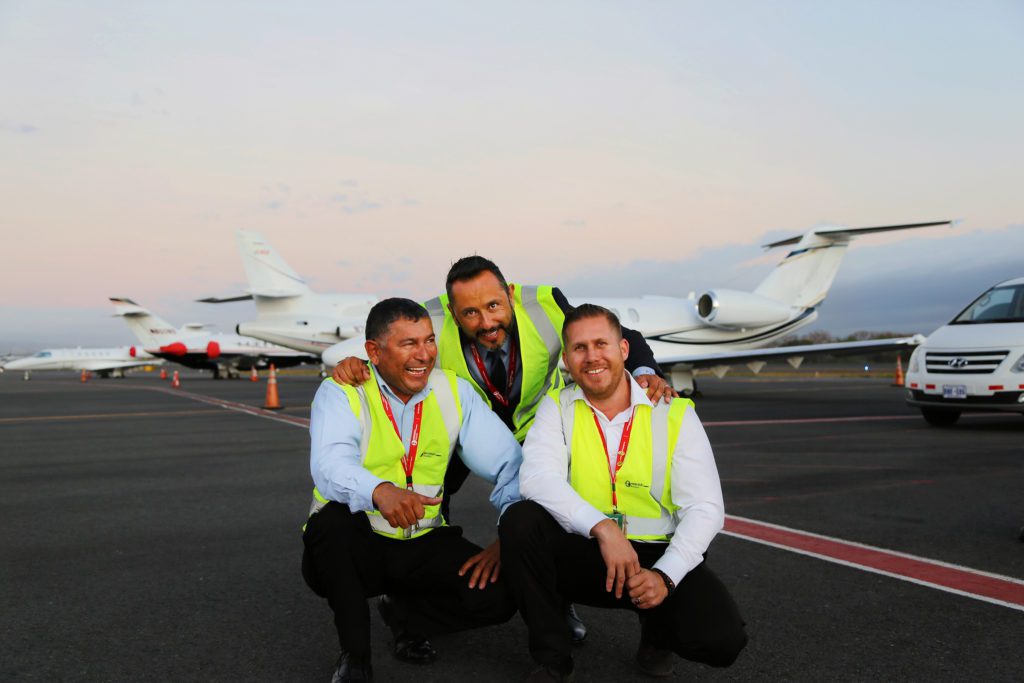
Universal Aviation Costa Rica has ground handling offices in San Jose and Liberia.
Domestic Airports
If you plan to use a domestic airfield in Costa Rica, you’ll need to arrive/depart the country via an Airport of Entry (AOE). Be mindful that special permits are required to travel to domestic airfields, and obtaining these permits can be difficult. This permit is known as a temporary importation, usually takes seven to eight business days to obtain, and can only be applied for after you land at an AOE in Costa Rica. Not many operators request landing permission at domestic airfields. If you choose to do this, it’s best to hire a local company to assist with the process. Issues in operating to domestic airports include unavailability of ground handling services and minimal airport security.
Permits
While landing permits are not needed for private non-revenue and charter (non-scheduled commercial) operations, there are certain limitations and considerations that must be taken into account regarding airport options and Airports of Entry (AOEs) when flying to Costa Rica.
Unless an aircraft operates on an experimental certificate, overflight permits are never needed for GA. For experimental aircraft, it’s recommended that the operator goes through diplomatic channels to obtain the needed permission faster. Landing permits are not required for either private non-revenue or charter operations. However, airports in Costa Rica require that all aircraft obtain prior parking permission. This applies to both Airports of Entry (AOEs) and domestic airfields. This Prior Permission Required (PPR) mandate is obtained via the relevant airport authority. CAA does not need to be notified of any parking approvals as the airports are the governing authority regarding aircraft parking. A private company runs MROC while the other three AOEs – Liberia (MRLB), San Jose Tobias Bolanos (MRPV), and Limon (MRLM) – are run by the government.
Cabotage
Cabotage is never an issue when operating between AOEs in Costa Rica. Aircraft operators are free to take onboard whomever they wish for these flights.
Operation to Domestic Airports – Temporary Importation Required
Operations to domestic airports in Costa Rica require that the operator temporarily import the aircraft. But this can only be done after you’ve landed at an AOE in Costa Rica. While no fee is involved, a temporary importation request takes approximately seven to eight business days to process. Therefore, a quick turn to a domestic airport immediately after arriving at an AOE is impossible. Documents required for temporary importation must be originals and include certificates of registration and airworthiness, worldwide insurance, and a power of attorney from the aircraft owner allowing the captain to request aircraft importation.
Processing a Temporary Importation
CAA will review submitted documentation to ensure no issues, and then customs will process the application. The captain will need to go to the customs warehouse at the airport to collect the approval papers. Some forms need to be filled out to complete this process, and all of these are in Spanish. It’s best to do this with your ground handler because of language and your ground handler’s familiarity with the process. CAA is very strict on limiting temporary importations due to operator unfamiliarity with domestic airport procedures. If a temporary importation is approved, you must provide the approval number to air traffic control to obtain permission for domestic travel. Temporary importations are valid for a maximum of 22 days, and you may leave and return to the country during this time. If you need to stay longer than 22 days, you must start the process again. If you remain in Costa Rica for more than 22 days with the original temporary importation permit, you’ll be charged taxes based on the value of your aircraft.
Local Charter Options – Better Than Temporary Imporation
Rather than temporarily importing your aircraft, it’s best to use a local charter operator for any required domestic travel.
Customs
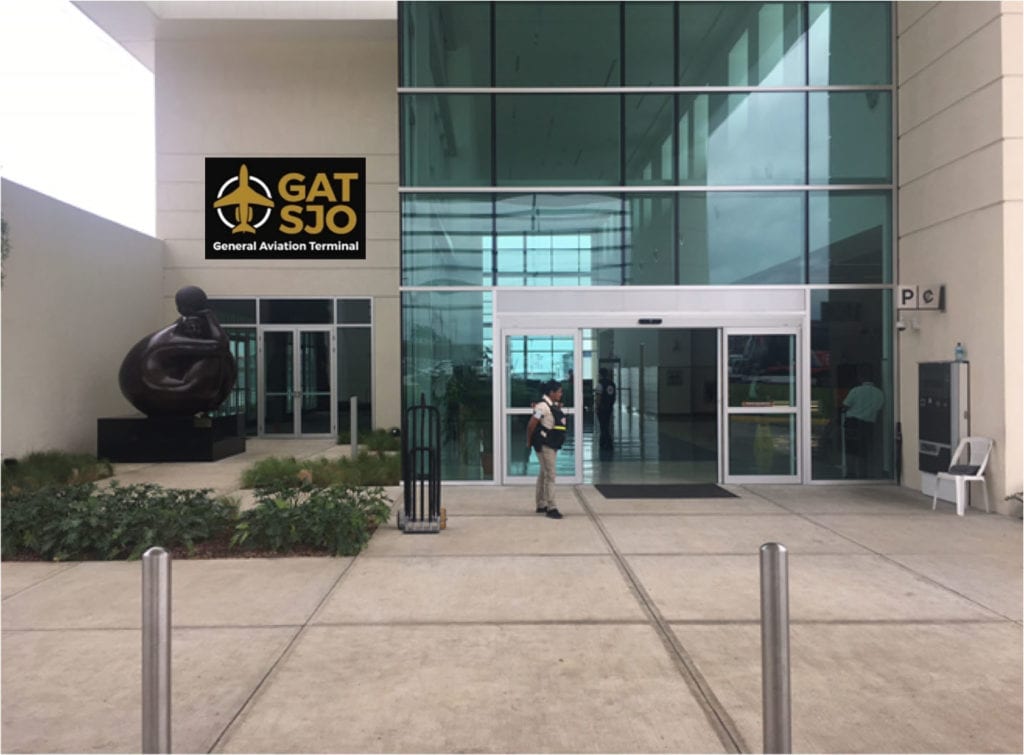
San Jose Airport now has a dedicated general aviation terminal with onsite Customs, Immigration, and Quarantine (CIQ).
While completed arrival cards are required for Costa Rica, departure cards are not needed. Your ground handler will complete arrival cards, as much as possible, prior to your arrival if you’ve sent crew/passenger information in advance. In the case of tech stops, arrival cards are not needed, and CIQ clearance is not required so long as crew/passengers do not embark/disembark. Operators may request arrival cards from their ground handler, and these will be sent by mail. Upon arrival passengers will be escorted by the ground handler to a separate CIQ/agriculture clearance line in the main commercial terminal. This is the process for all airports of entry in Costa Rica with the exception of San Jose, which now has a dedicated GAT for private aviation. This is the same clearance lane used by crew members, minors, and diplomatic personnel. Luggage is brought in to be X-rayed and on occasion may be hand-screened at the discretion of customs. Clearance time is typically 10-15 minutes, depending on the numbers of passengers, crew members, and bags. There may be occasional clearance delays, however, if you’re clearing at the same time as a large number of commercial crews, minors, or commercial passengers needing assistance. Crew members clear inbound CIQ after the aircraft has been shut down. For departure, crew members usually clear two hours prior to the estimated time of departure. No fees are associated with CIQ clearance in Costa Rica.
Onboard CIQ clearance
Depending on your passengers and their VIP status, CIQ clearance is possible with advance notice. This requires pre-approval from CIQ, airport authorities, and local police with a recommended minimum of five business days lead-time. With a patient onboard, air ambulance flights are cleared on the aircraft, and ground ambulances will be permitted to pick up/drop off airside. Local government authorities take over the clearance process for diplomatic flights and arrange special parking and CIQ clearance.
Documentation
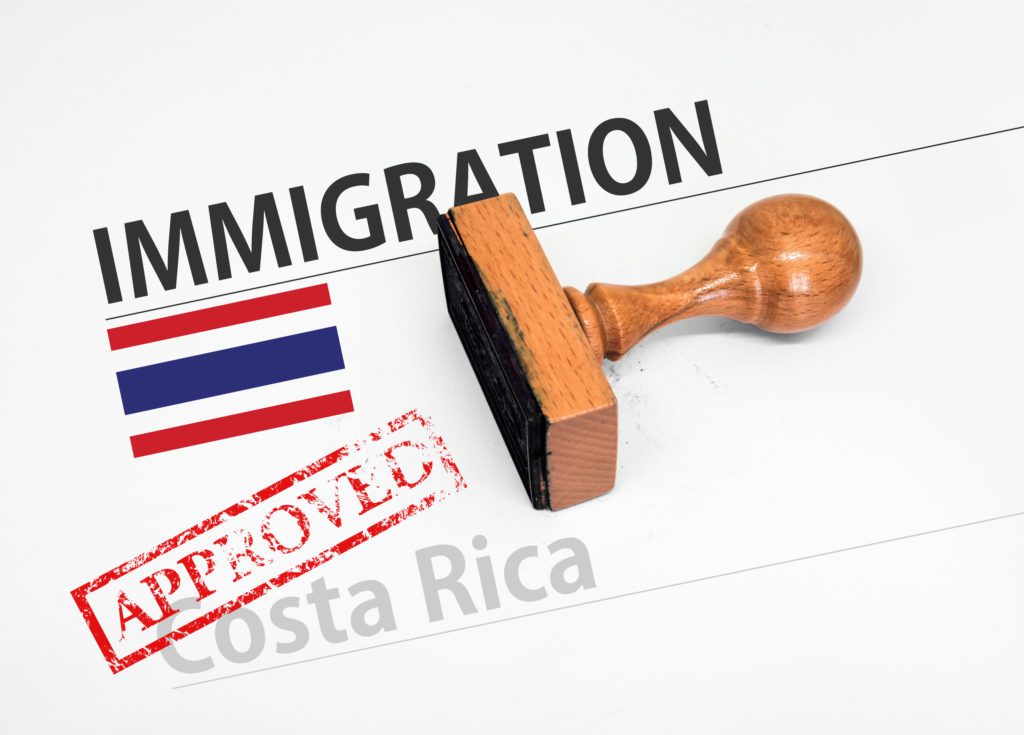 Passport Requirements
Passport Requirements
Valid passports are required for all passengers and crew members. However, rules on the length of remaining passport validity vary depending on nationality. When you arrive from certain countries, including the U.S., it’s usually sufficient to have passport validity to cover your length of stay in Costa Rica. Other nationalities, including Colombian and Nicaraguan, usually require a minimum of six months remaining validity on passports. It’s best to confirm this with your ground handler well before travel.
Visa Considerations
Depending upon nationality, a visa may be required to enter Costa Rica. Note that visas are not processed upon arrival under any circumstances. Crew members may be permitted to enter the country with valid U.S. visas – even though your passengers may require Costa Rican visas. But it’s best to confirm requirements with your ground handler in advance. Be aware that visa requirements can frequently change depending on the government in power, local customs mandates, and the current director of the Civil Aviation Authority – so be sure to “know before you go.”
Arrival Cards
Arrival cards are needed for all passengers/crew members. If the required information is provided in advance, the ground handler will have arrival cards completed and ready upon your arrival.
Agricultural Considerations

In general, no fresh or unpackaged foods may be brought into Costa Rica. However, there are exceptions, so it’s essential to check in advance. It may be possible to store onboard catering at the airport with advance arrangements. If passengers need to bring in special foods or dietary items, approval may be obtained upon presentation of appropriate paperwork in advance.
Pets

Pet dogs and cats are permitted entry to Costa Rica with appropriate health certificates and documentation. In addition, you must provide documentation showing where you purchased the animal. If the animal does not have the appropriate paperwork, it will be put down upon arrival.
Weapons
Costa Rica does not allow hunting within the country. If you wish to bring in guns, there’s an arduous process with which you must comply, which involves advance notification to several different governing authorities. Generally speaking, we recommend you avoid this if possible. But there are no issues with having guns/ammunition onboard during international tech stops. However, if your aircraft remains overnight with guns on board, you’ll need to pre-advise local authorities. Airport authorities will post a security guard at your aircraft, and there will be an additional charge for this service.
Alcohol Restrictions
Each passenger is permitted to import up to five liters of alcohol. Anything more than this requires proper notification and payment of applicable customs duties. Otherwise, any excess will be confiscated. If you’re bringing in quantities of alcohol above duty-free limits, it’s best to coordinate this with your ground handler and have a customs broker involved.
Flight Planning
When traveling through Costa Rican airspace, no special regulations exist, and air traffic controllers speak English. Be aware that smaller airports, including domestic airfields, may not have a tower. For example, San Jose (MROC) Air Traffic Control (ATC) tower covers Limon Int.’l (MRLM).
Flight plan offices, known as “EROs,” are located at international airports with opening hours mirroring airport operational hours. Flight plans may be filed electronically, but a hard copy of your flight plan must be given to the ERO office. The captain or a dispatcher must sign all flight plans. If the ERO office approves your flight plan, it will be forwarded to ATC. If changes to your flight plan are needed, ERO will let the ground handler know so that the agent, along with the crew, can make the appropriate changes and re-file.
Day-of-Operation considerations
Flight plans for Costa Rica should be filed four hours before departure. Your flight plan remains on file for one hour after the Estimated Time of Departure (ETD). Whenever a flight plan is generated via a 3rd-party provider, the ground handler will confirm that the routing is on the flight plan, have the captain or a dispatcher sign it, and then take it to the ERO flight plan office for processing. Be mindful that the ERO flight plan office will review your filing to ensure that aeronautical fixed telecommunication network (AFTN) addresses are properly notified for downline legs and countries.
Modifying Time of Departure
If you anticipate a flight delay, the ERO flight plan office must be notified. Be aware that you may only request two operational delays in Costa Rica. After that, you’ll need to file a new flight plan and start the process again. Some operators choose to file flight plans for an hour after ETD to maximize operating flexibility and avoid delayed messages. When you’re ready for takeoff, call ATC to request clearance.
Flight Planning to Domestic Airports
Before traveling to any domestic airport in Costa Rica, you must first temporarily import your aircraft. This must be done before filing a flight plan from an international airport to a domestic airport. Note that travel between domestic airports does not require a flight plan. Once you depart a domestic airport for another domestic airport, you’ll communicate with ATC and provide your temporary importation permit number. Be advised that the Civil Aviation Authority (CAA) limits temporary aircraft importations given to non-Costa Rica-based aircraft. This is because operators unfamiliar with flying between domestic airports in Costa Rica may cause issues.
Equipment Requirements
Reduced Vertical Separation Minima (RVSM) and Traffic Collision Avoidance System (TCAS) II are mandated for all operations to Costa Rica. Therefore, it’s essential to ensure that proper equipment designations are included in your flight plan. ERO, the flight plan office, will always check this information before confirming a flight plan filing with ATC. If you do not have the required equipment/certification, you’ll be restricted to certain flight levels. At some point, Automatic Dependent Surveillance Broadcast (ADS-B) will become a requirement for operations through Costa Rican airspace, but details on this are unknown at this time.
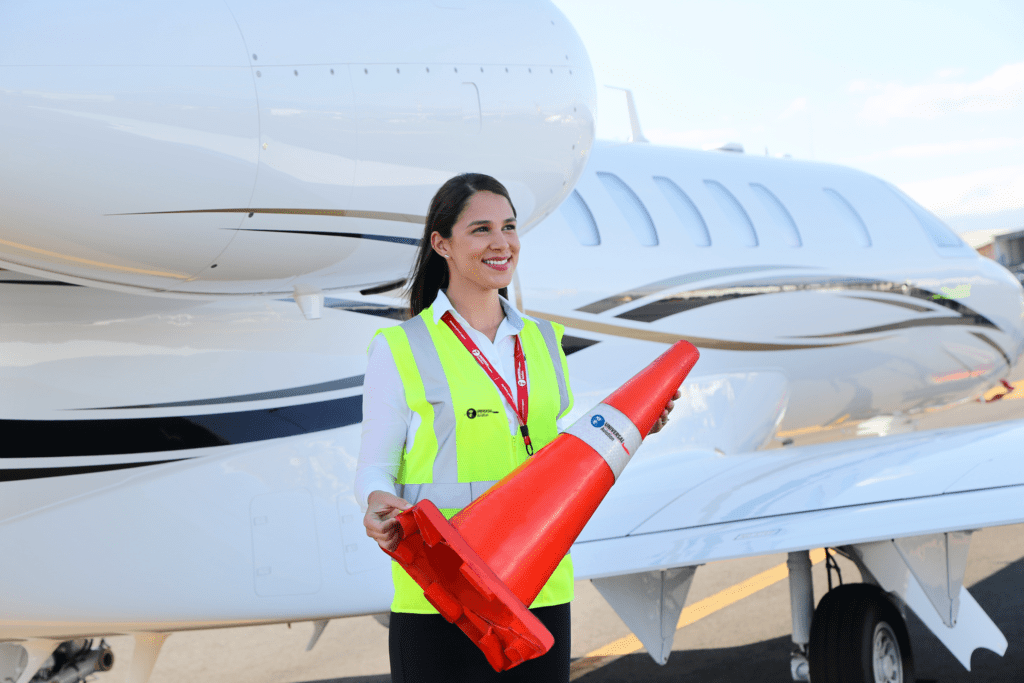
Weather
Weather is generally very good during the late November through early April high season. Expect potential for heavy rain during the traditional rainy season: August through November. In certain parts of the country, fog can be an issue. The fog here usually occurs at night but, occasionally, can be an issue during mornings.
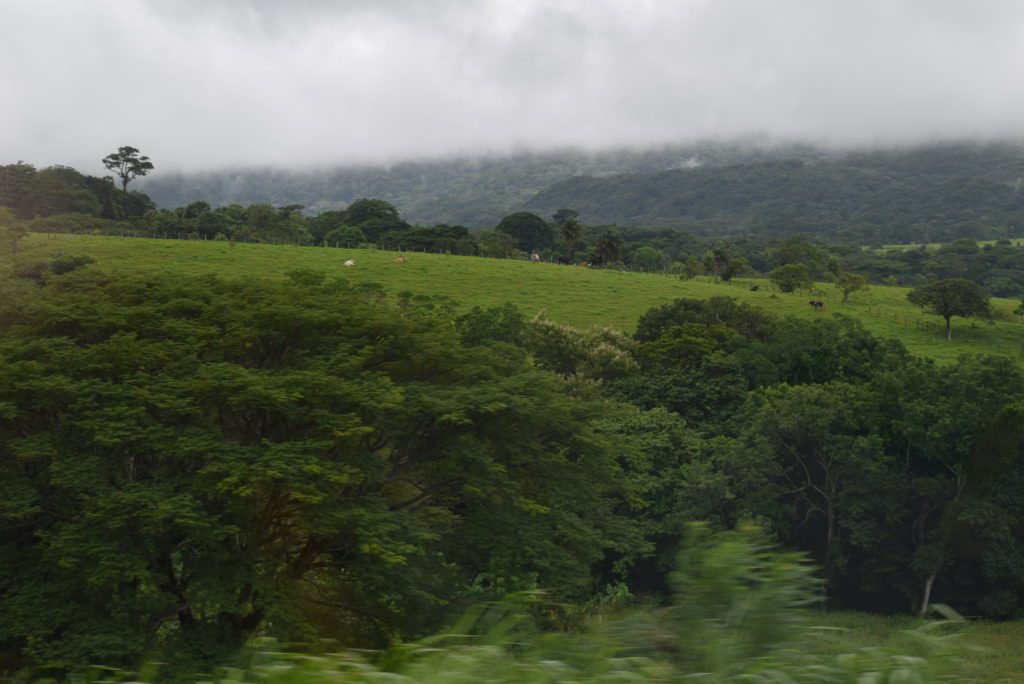
Airports in Costa Rica may close if there’s heavy rain or fog. During the rainy season – particularly in September – airport closures are a consideration to be mindful of. During times of significant fog, airport closures may occur for precautionary reasons. It’s recommended that operators always check on the local weather day of operation.
All international airports in Costa Rica have weather offices where the crew may obtain weather for both in-country and outside-country operations. This department will, upon request, provide you with NOTAMs for Costa Rica and international locations with no fees/charges involved. Local weather offices are open during the same hours that the airport is open – 24/7 for MROC and sunrise to sunset for San Jose Tobias Bolanos (MRPV). While these weather offices are available to all flight operations, there are no requirements that crew must go there for briefings.
Peak Season

Be aware of constraints when operating during the November-to-March high season and when using domestic airfields. Your local ground handler should be able to help you arrange a successful mission to this country and give yourself an advantage by planning ahead as much as possible.
During the late-November-to-early-April high season, MROC often experiences parking issues due to the number of aircraft traveling to this location. In many cases, Notices to Airmen (NOTAMs) will be issued restricting overnight parking for GA aircraft. MRLB also has issues with overnight parking during the peak season. There may be cases where you’ll need to drop passengers and reposition aircraft/crew elsewhere in the country or outside Costa Rica. Note that no hangar space is available for transient GA movements at any AOE in the country. While there are a few small hangars – for commercial airline maintenance and local GA aircraft – hangar space is not rented to transient GA operations under any circumstances.
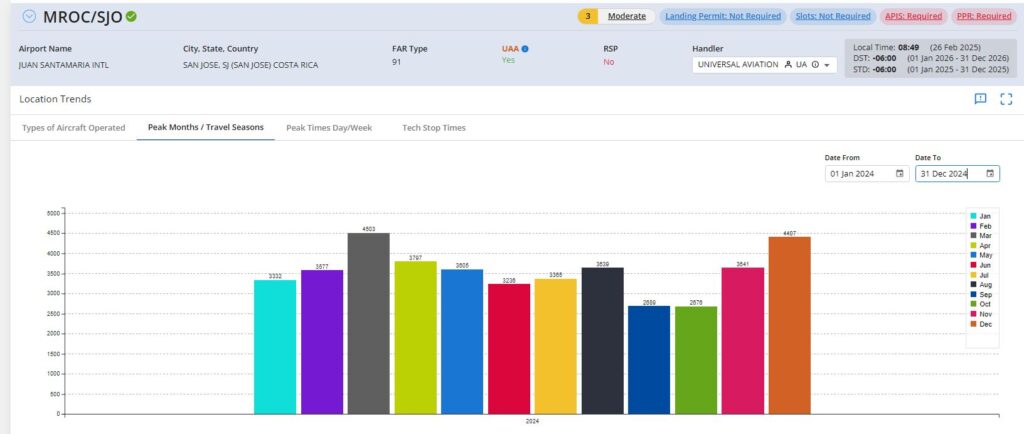
You can view destination insights such as busiest months and travel seasons for popular airports in Coast a Rica in Feasibility-IQ.
Tech stops
Aviation fuel uplifts in Costa Rica, particularly for tech stops, are often accomplished very quickly. However, there are times when significant fuel delays can occur, depending on arrival time, season, day of arrival, and aircraft type. Fuel uplift delays may be as long as several hours during the high season – particularly during peak hours of 1300-1600 local. If you’re operating to Costa Rica during the high season, it’s best to schedule fuel uplifts outside 1300-1600 local hours.
Regulatory considerations
Departure taxes
Be advised that there’s a departure tax payable of about 30 USD per passenger when leaving Costa Rica. The best way to pay this is via your ground handler, who’ll issue you departure tax receipts to show to customs and immigration at the airport. Otherwise, you’ll need to pay this tax at a bank office within the airport. Payment can be made either with cash or credit card, and you’ll show proof of payment of this at the security checkpoint. Be aware, however, that during high season and busy periods, it may take 30-45 minutes to pay departure taxes at the airport. The best practice is to have your handler take care of departure taxes in advance to avoid any potential delays.
Vaccinations
If you’re arriving from an area considered endemic for yellow fever – including Brazil, Ecuador, Bolivia, Colombia, Peru, and Venezuela – vaccination certificates are required for all crew members/passengers. If you don’t have those certificates, CIQ authorities will not allow you into the country. There are, however, exceptions for tech stops. If you’ve made an international tech stop at one of the above-noted countries, and no one has embarked/disembarked, yellow fever vaccination is not required. For more information on vaccination requirements, see the “Fly2SanJose” website.
Cultural considerations
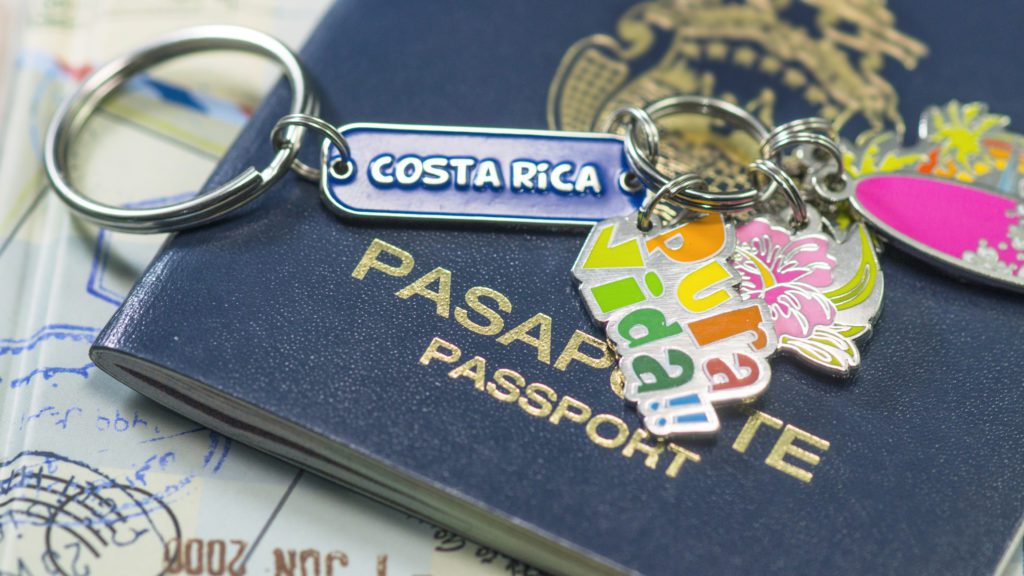
There are many things to see and do in Costa Rica – from volcanoes and museums to nightlife and beautiful beaches – if you have the time. A wide range of international restaurants and cuisine styles are available in cities, towns, and tourism areas. Seafood options in the country can be excellent.
Be aware that roads in Costa Rica may be narrower than you’re probably accustomed to. Local driving can be tricky in some areas, and road signs in Costa Rica are relatively rare; it may not be easy to get around if you don’t know where you’re going. Consider bringing your GPS or renting one (with English and Spanish configurations) from your rental car company.
The risk crime is relatively low in Costa Rica. In the southern province, these risks may be a little higher. Just as with any larger city or tourism area, anywhere in the world, certain areas should be avoided, and your ground handler can advise you on this.
Universal Aviation Costa Rica can help
Universal Aviation has had a presence in Costa Rica for several decades. Our primary locations are in San Jose and Liberia. We also provide on-airport supervision at destinations across Costa Rica. More information and team contact info are available on our website.



